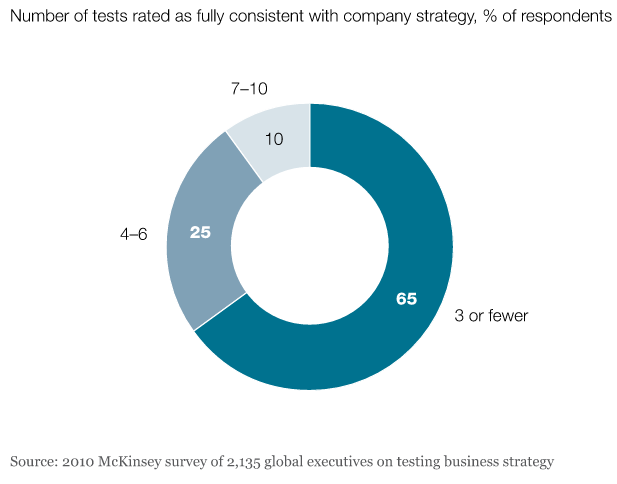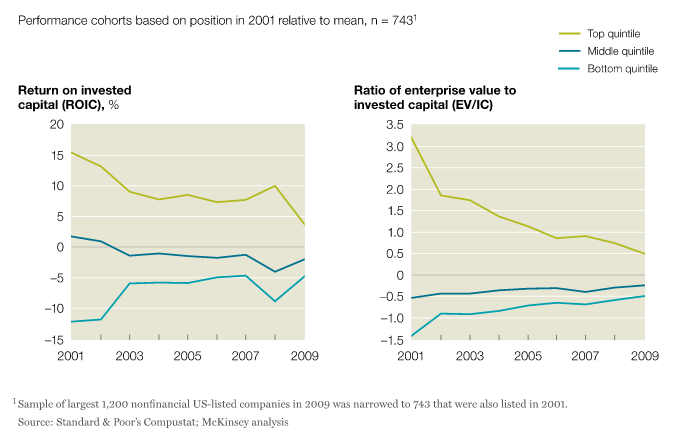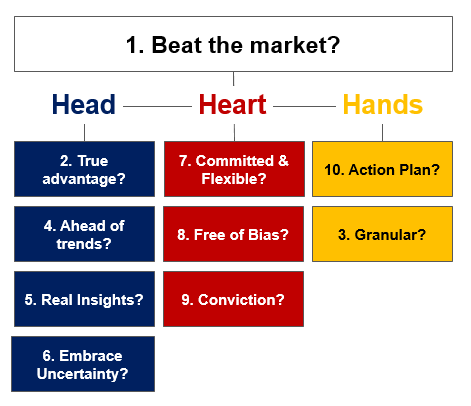McKinsey’s advice
McKinsey, in a 2011 article entitled Have you Tested Your Strategy Lately here, makes the very valid point that executives and leaders too often treat strategy as a ” procedural exercise or set of frameworks”, rather than a way of thinking through problems. Their advice: Don’t look for the newest strategy fad or business guru, but instead take your strategy, and stress test it. Amen.
we need to apply what we already know
Keep it simple and consistent – rather than piling more stuff in your head. Simple analogy. We all know what makes us fat (too many calories and not enough exercise) – and yet 50%+ Americans are considered obese. Yes, it requires your head, heart and hands.
Most companies’ strategies pass fewer than 4 of the 10 tests
In true McKinsey style, they applied a lot of rigor to what seems like a qualitative exercise. They ran it by 700 strategists and 2,100+ executives; they found that most company strategies pass fewer than 4 of the 10 tests. Fascinating, and kind of not surprising.
1. Will your strategy beat the market?
This is the main question. Is your company able to harness some competitive advantage – economic moat – which allows it to create and keep more value than competitors? Think of Porter’s classic 5 forces framework; everyone (suppliers, buyers, substitutes) can eat away at your profits. What is keeping your share of profits safe?
The goal of strategy is to create and sustain a competitive advantage. It’s not about “beating your competition”, it’s about winning at the game that you have set out to play. Play your own game, not FOMO, someone else’s
Markets drive reversion to the mean
This chart is sobering. From 2001-2009, the top and bottom quintile of company performance (measured in ROIC) are converging; the great gets worse, and the worst are getting better. Clearly, operational efficiency is not strategy.
How would I explain this to my cousin? Performance is getting average-y.
2. Does your strategy tap a true source of advantage?
Without getting into a mini-course on strategy theory, the few key questions to consider:
- Do you have a positional advantage in your industry? Do the right customers seek you out?
- Do you have control over valuable resources (e.g., patents, process knowledge, management)?
- Have you bundled activities together so it’s hard for your competition to mimic you? Causal ambiguity.
3. Is your strategy granular about where to compete?
In marketing we learn about STP (segment / target / position), but McKinsey argues that companies do not segment enough. They urge you too think deeply about customer, geographic, and product-using segments. In a separate article called the Granularity of Growth here, McKinsey notes that companies need to “de-average” their approach to different markets. Clearly the days of mass-market are dead.
This article was published in 2011, how much better have we gotten at micro-targeting and direct-to-consumer marketing? It’s pretty much heresy for any executive to talk about “customers” and “markets” generically.
4. Does your strategy put you ahead of trends?
Self-explanatory.
5. Does your strategy rest on privileged insights?
This is a fancy way of saying do you have unique information, data, analysis, and insights? There is a sea of data, but that’s the obvious field that all competitors look through. Find out what is happening at the edges of the industry and try to pick up the weak “signals” buried with the noise. They suggest rigorous brainstorming on what key questions could dramatically disrupt, change, challenge your business. This leads to the next question. . .
6. Does your strategy embrace uncertainty?
In this VUCA (volatile, uncertain, complex, ambiguous) world, you cannot predict anything with certainty. That said, is it a binary – I know, I don’t know? What are the shades or gray? McKinsey characterizes 4 levels in blue font below:
Level one offers a reasonably clear view of the future: a range of outcomes tight enough to support a firm decision. At level two, there are a number of identifiable outcomes for which a company should prepare. At level three, the possible outcomes are represented not by a set of points but by a range that can be understood as a probability distribution. Level four features total ambiguity, where even the distribution of outcomes is unknown.
Believe this is the fundamental difference between strategic planning (which we ALL do), and the realization that customers can do whatever they want. They don’t have to like your new product. Also, rivals and new entrants get a vote. They hire a bunch of smart people too. There is a LOT of uncertainty out there, so let’s be realistic about this.
7. Does your strategy balance commitment and flexibility?
While reading, I had no idea how McKinsey would answer this one – but love the simplicity of this statement:
A market-beating strategy will focus on just a few crucial, high-commitment choices to be made now, while leaving flexibility for other such choices to be made over time.
Whoop, whoop. This is THE POINT. If we agree on #1-6, then it comes down to making some good decisions, smart bets, a strong culture to make emergent strategy decisions, and get on with it. Management is a practice; it’s not a formula, framework, or fancy strategy diagram. Are you consistently making better decisions, more quickly than the competition.
Or are you having a meeting to get alignment on anything not in the strategic plan?
Major on the majors, minor on the minors
Like the idea of really focusing, analyzing, stewing, worrying over the most important decisions and committing. For the other details (the other branches of the fishbone diagram, or lower-level issues), you can flexibly respond and stay opportunistic. Get the big things right.
If I were to ask your executive team, or 2-3 levels down in the organization, how would they answer these questions:
- What’s your unique positioning? What are the 2-3 BIG things that differentiate you from rivals?
- What’s the biggest 2-3 drivers for the company to win in the next part of the business cycle?
- How does the company’s strategy map to your department goals and your personal career?
Do you think the responses would be awesome or a bit nail-biting?
8. Is your strategy contaminated by bias?
Without further reading, the answer is yes. McKinsey goes through a list of potential biases – all things we learned in Bschool – over-optimism, anchoring, loss aversion, confirmation bias, herding, and champion biases. Yikes, what is in our heads can often work against us.
Reed Hastings, an iconoclast and co-founder of Netflix, explains that CEOs need to “farm for dissent.” It’s too easy for leaders to surround themselves with people who always say “yes, boss”. That is poison for decision-making.
9. Is there conviction to act on your strategy?
For me, this is perhaps the biggest fail of most corporations. They don’t stick to 1 strategy long-enough to really know whether it works or not. Since the average CXO tenure is a few years, there is someone coming / going from the executive suite every month. Can you imagine if your Premiere League football team had a revolving door of players? How much coordination do you think they would have?
If you’re not making mistakes, you’re not making decisions – Catherine Cook
10. Have you translated your strategy into an action plan?
Self-explanatory.
Whoa. This is a long list, What’s the big Takeaway?
Long lists are hard to remember or internalize. Therefore, I put together this grouping which fits my worldview – it takes your head, heart, and hands to solve problems.
Basically, strategy is hard. That’s why it’s difficult to beat the market consistently – in stock investing, and your career.
Head (analysis, data, facts, logic):
- Do you have a true advantage based on unique insights or are you just downloading recent analyst reports?
- What do you have that is unique to you? Could I copy/paste your analysis and it would be just as relevant to others?
- Do you have a culture of intellectual honesty and aggressive curiosity? or is it a stew of politics?
- Are you diligently looking for leading indicators and ways to parse through messy real-time information?
- Are you working through legacy problems; solving yesterday’s issues?
Heart (passion, drive, founder’s mentality):
- Are you committed to your plan, yet flexible enough to make adjustments?
- Are you “wed” to old strategy that is not working?
- Would your target customers say that “they understand us better than competitor X?”
- Do you have a turnover problem? Why should people work here? What’s in it for them?
- If you were 25 years old, would you want to work here?
Hands (implementation, change management):
- Is your strategy easy to implement? When the company wants to do X, how many meetings are needed?
- Is your employee engagement high? High enough to be a catalyst for customer engagement?
- Do you have a culture of managing risk or leading change?




Great article. One thing I think seems to be missing is if you are engaging your workforce in this strategy. In a room of MBAs, CEOs, and other executives, all the data, trends, expert opinion, and debate make sense. But turning around and then telling people that they need to change, without involving them in the strategy can make strategies get stuck.
Completely agree. There is a false separation between strategy and implementation; it takes consistent, year-over-year leadership, communication and trust-building to move an organization. It is much more than a fancy powerpoint and analysis. Agreed. It is hard.
Absolutely Steven!
Executives often ignore the “power of engagement”. It appears that there is a certain jealousy, like if in involving people they would take credit away or make the process unnecessarily longer, but that’s exactly the contrary. By including people in strategy, the chances of success are much more likely.